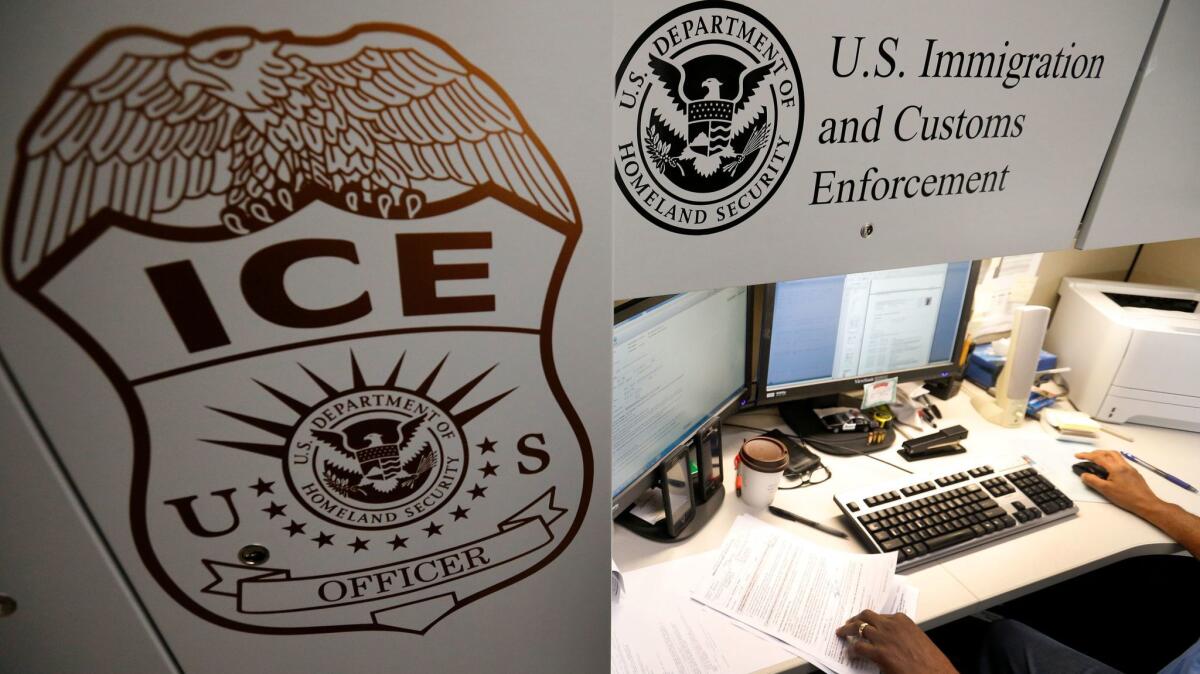Targeted immigration arrests in San Diego area have more than doubled under Trump

The number of targeted immigration arrests in San Diego has returned to levels from before former President Obama changed enforcement priorities in late 2014, according to ICE data.
That’s in large part because of the broadened priorities mandated by President Trump in a January executive order, according to Greg Archambeault, San Diego field office director for Immigration and Customs Enforcement’s Enforcement and Removal Operations.
Obama’s priorities focused on people convicted of felonies or multiple misdemeanors. Trump’s policy includes people charged with any level of crime and those who have final orders of removal, meaning an immigration judge has already signed off on their deportations.
“All we’re trying to do is protect the community and remove the threats,” Archambeault said.
Since Trump’s immigration policy changes, news stories about immigrants being picked up by officers in unmarked, gray SUVs have spread quickly from coast to coast. The ICE team responsible for those targeted arrests is called fugitive operations.
From February through May of this year, San Diego’s fugitive operations team has arrested 547 people, according to data from ICE. That’s more than double the total for the same months last year, at 242, or the year before, at 267. In 2014, before Obama narrowed immigration enforcement’s priorities, San Diego’s fugitive operations team arrested 540 people in the same time frame.
“We’re still focusing on criminals, but we’re not confined to them,” said Clinton Johnston, assistant field office director for Enforcement and Removal Operations in San Diego. “It’s the ability for us to enforce the law across the board.”
The team works in groups, investigating the lives of people ICE believes are removable from the U.S. The groups go out daily to knock on doors and try to pick up their targets. They are allowed to knock anytime between 6 a.m. and 10 p.m., and they frequently start their work days before 6 a.m. so that they can be outside their first stop when the clock strikes six.
On a recent Wednesday morning, a squad of unmarked vehicles set out for Chula Vista to arrest three people: a 23-year-old immigrant from Mexico who overstayed his visa and was convicted in April for driving under the influence; a 61-year-old green card holder from Mexico with a conviction for spousal battery; and a 55-year-old Cuban man who had been ordered deported because of several felony convictions.
The officers believed that the 23-year-old lived with his parents, who had also overstayed their visas, and they intended to initiate court proceedings for the parents as well.
After arriving in the family’s neighborhood, some of the gray SUVs synchronized passes along the family’s street while others on the team stationed themselves around a corner, waiting to move in. A neighbor putting mail in a mailbox stared at the waiting cars before heading home.
At 6 a.m., all of the team’s cars converged on the family’s street. Another neighbor walking her dog in the early morning turned to watch before hurrying away.
Three officers walked to the front door while two more guarded the perimeter of the house, which had several cars and a basketball hoop in the driveway. The mother came to the door but declined to open it.
Fugitive operations officers can’t go into a house without permission.
The team spoke with the mother through a window, but they soon realized they were not going to be able to take action.
They told the officers waiting in the driveway what happened as they walked back to their cars.
“That’s OK. We’ll get them next time,” Johnston said.
They might try again at the target’s work or surveil the house until the family leaves and then do a traffic stop, Johnston said.
Targets have more frequently declined to open their doors since Trump took office, he said.
By 6:14 a.m., the gray SUVs were heading to the second target’s house in a nearby neighborhood with large homes. The man’s daughter answered the door and told them that he was at work.
Johnston said he expected that the man would turn himself in at the Federal Building to avoid having ICE officers come back to his house.
At 6:36 a.m., the officers were back on the road, heading to the third target’s apartment, which was above a shop. Those working inside peered out at the agents as they spanned the perimeter. Because the man had drug and weapon convictions, the officers were wary that this stop might be dangerous.
The man, Emilio Sotomayor, went with the officers without resistance, leaving his partner and their two sons in the house.
Depending on the situation, ICE officers don’t always take a target into custody, Johnston said. If the person is a sole caregiver to children, officers weigh that with the likelihood of a public safety issue. They might give the person a notice to appear in court instead of driving them downtown. Because Sotomayor’s partner was home, this wasn’t an issue in his case.
Officers patted him down and placed him in the back of one of the SUVs. By 7 a.m. they were driving through morning traffic back to the Federal Building downtown to process Sotomayor and tell him that he would soon be deported to Cuba.
“Wow, I still can’t believe it,” Sotomayor said after receiving the news at ICE’s processing facility. “You’re sleeping, and they’re knocking on the door. They bring me here and tell me, ‘You’re going to Cuba.’”
Morrissey writes for the San Diego Union-Tribune.
To read the article in Spanish, click here
Twitter: @bgirledukate
More to Read
Sign up for Essential California
The most important California stories and recommendations in your inbox every morning.
You may occasionally receive promotional content from the Los Angeles Times.










